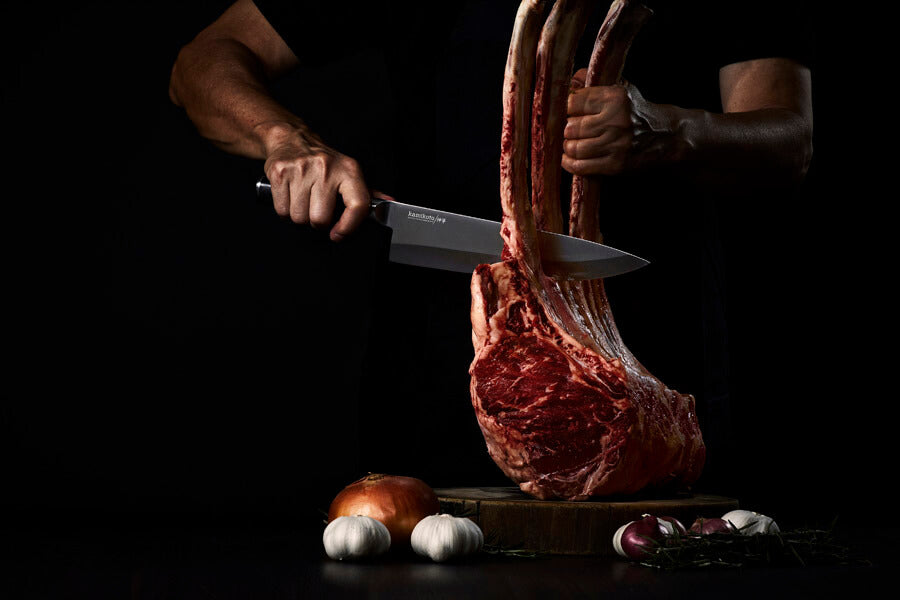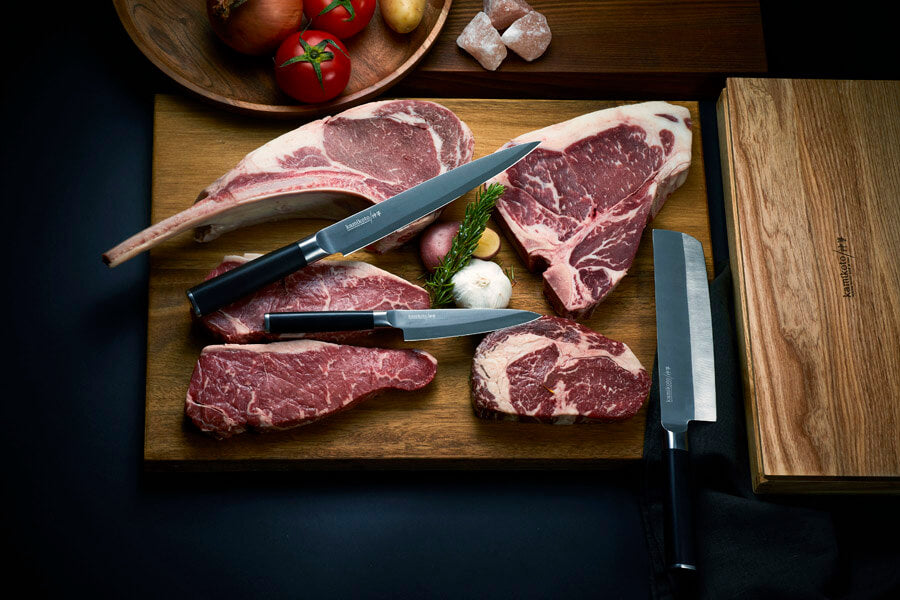
Deboning involves using a specialty knife to separate flesh from bones be it meat, poultry or fish. Learning to debone is an advanced culinary skill that takes much practice to perfect, a skill that is vital to develop to take one’s gastronomic prowess to the next level.
Bone or Debone - Why Debone Meat?
While chefs often choose to keep bones in when cooking different cuts of meat or poultry, there are a number of benefits to deboning them first. This is particularly the case if using a dry cooking method such as roasting.
Contrary to popular belief, keeping the bone in does not enhance the overall flavor of the meat when roasting. This is because the flavor-filled part of the bone – the marrow – cannot escape from the bone during this cooking process. However, when the meat is simmered or braised, it does break down and dissolve thanks to the hot liquid, giving the sauce or broth added depth of flavor and richness.
What follows is a selection of other deboning benefits.
Deboning Meat: Cooking Benefits
-
Seasoning - chefs can roll and stuff large cuts of meat. This is a great way to enhance flavor as well as retain larger amounts of moisture, making for very succulent meat.
- Speed – deboning speeds up the cooking time as bones take longer to heat through than flesh.
- Safety – taking the bones out evens up the amount of cooking time required for large pieces of meat. For example, removing the backbone from a turkey ensures it cooks evenly, making for a safer meal.
- Budget – it is generally more expensive to buy fully butchered meat. Many professional chefs find it is more cost-effective to buy larger cuts, and then break down and de-bone themselves.
-
Carving – it is much easier to carve a piece of deboned meat.
- Upskill – learning to debone meat, fish and poultry is a great way to advance one’s culinary skills repertoire.
Developing the Skill of Deboning Meat
When it comes to acquiring the skill of successfully deboning meat, it all comes down to the correct knife choice. Using the wrong one can result in:
-
Kitchen accidents: due to the extra force needed when making deep deboning cuts
-
Badly butchered meat: which affects the dish’s overall flavor and presentation, plus creates meat wastage
- Time inefficiencies and frustration: as it takes longer to perform the job
The first step then in the learning how to debone is to choose the correct knife.
Required Equipment for Deboning
There are two specialty blades chefs use when deboning: a boning knife and a filleting knife.
The choice of knife is highly dependent upon the type of food the chef is cutting. If deboning and breaking down large cuts of meat, a boning knife is the best option. For fish, a filleting knife is recommended.
Poultry is slightly unique in that both types of knives can be used. The boning knife is good for larger sections of the bird such as the backbone, but a filleting knife is useful for smaller joints, removing breast fillets and skin, plus fine slicing work.
The type of blade also plays a part. Stiff blades are excellent for big cuts as they can handle the pressure required to remove bones and sinew, whereas a more flexible blade is essential when working with delicate flesh like fish or poultry breasts. For example, a curved filleting knife is perfect to remove fish bones in one smooth cut, whereas a stiff boning knife can easily handle making deeper cuts to the bone in a thick piece of meat.
Features of boning and filleting knives
Boning Knife
-
Narrow blade, straighter edge
-
Sharp tip
-
Slightly stiffer/less flexible than filleting knife
-
Approx. 5 – 6.5 inches in length
-
Best used: to debone and break down thick cuts of meat (beef and lamb, some poultry parts)
Filleting Knife
- Narrow, curved blade
- Sharp tip
- Very thin/more flexible than a boning knife
- Ranges in size from 6 to 11 inches
- Best used: to debone fish as well as certain parts of poultry (small joints, removing skin, separating breast fillets)
The Correct Way to Debone Types of Meat
Once the right knife has been selected, it is time to learn the art of separating flesh from bones. As each protein type has a different bone structure and shape, there are a few different deboning techniques to develop as detailed further below. However, some general guidelines can be followed.
A few starting tips
- Ensure the knife is razor sharp
- Do not rush the process when starting out deboning (this ensures the right cuts are made and accidental slips and injuries are avoided)
- Use the non-cutting hand to stabilize the protein at all times
- Ensure the non-cutting hand is positioned well away from the knife when making cuts
- Use a sawing motion when making cuts in large meat and poultry pieces
- Use a gliding/sweeping long cut when filleting fish
- Gently pull meat away from bone to help with the separating process
How to Debone Beef

As most beef cuts are thick and tough, using a boning knife with a stiff blade is recommended. There is also a wide variety of beef cuts so one’s technique must adjust for this. What follows are some overall procedures to use on most cuts.
General beef deboning tips
- Place the meat in the center of cutting board
- Find the first bone with the non-cutting hand & grip it securely
- Use the tip of the knife & angle it slightly, then make a preliminary cut along the length of the bone separating the meat (keep the knife as close as possible to the bone to avoid wastage)
- Keep making slices along the length of the bone until it has been separated
- Remove the bone
- Tidy up the meat cut by slicing away any long pieces of sinew or cartilage
How to Debone Lamb
There are various cuts of lamb which require slightly different deboning techniques. One of the most common cuts is a leg of lamb. Deboning usually involves taking out one central bone but if the shank is also attached, remove that before beginning by slicing it off.
Deboning lamb leg
-
Locate both ends of the bone, feeling how it runs through the meat
-
Once identified, using the tip of the knife, start making smooth incisions down the length of the flesh until the tip hits the bone
-
Continue to trim around the bone with small cuts, keeping as close as possible to the bone to avoid meat wastage
-
When the entire top of the bone has been exposed, grip the exposed portion
-
Start trimming underneath using the tip of the knife, cutting towards the end joint
-
Once at the end joint, slice the flesh completely away from the bone
-
Grip the free end of bone and then keep trimming all the way to the opposite side joint, removing the whole bone
-
The leg is now deboned and ready to be trimmed and stuffed if required
How to Debone Chicken
There are multiple methods of deboning a full chicken but the most common is not actually ‘deboning’ – it is more a breaking down of the bird so one has multiple pieces to work with. Again, it is much more cost-effective to buy a whole bird and break it down, then purchase individual pieces.
Experimenting with a variety of deboning chicken methods is an excellent way to discover which technique is the best fit. The following is an example of one method but explore others too.
Deboning full chicken (breaking it down)
- Ensure the chicken cavity is free of gizzards and organs
- Begin by focusing on one part/bone at a time
- Place chicken on cutting board breast side up
- Remove the wings first by locating the joint and feeling for where it connects to the body cavity and then slice through
- Move to the legs and thighs. Pull one leg away from the chicken and slice through the taut skin. This helps to identify where the joint is.
- Slice through a little further and then bend the whole leg back until the joint pops. It should now be quite easy to cut and remove the full leg and thigh piece. Turn the chicken as needed to achieve the cut.
- Remove the breasts next by making a smooth cut down between the two breasts until the knife hits the keel bone.
- Slip knife against the rib cage and make small, even sliding cuts in a horizontal direction to free the breast.
How to Debone (Fillet) Fish

As fish has very tender, delicate flesh it is important to use a specialty filleting knife that is curved and very flexible.
Once again, there are many different fish varieties thus shapes, so deboning or filleting techniques need to adjust to account for this. The following method is for medium-sized fish.
Filleting medium-sized fish
-
Scale and gut the fish first if this has not already been done
-
Make an incision at the fish neck following the groove of the gills until the knife hits bone (alternatively, chop the fish head off at this same point)
-
Placing the guiding hand on top of the fish, with the backbone closest to you
-
Make a small cut at the top of the backbone where the first incision was made
-
Slide the knife into this cut and then glide it down the full length of the fish in a smooth, almost horizontal motion to the end of the tail and slice through it. The knife should be held as close as possible to the backbone
-
Turn the fish over and repeat the same process
-
Feel for pin bones in the fillets and if any, remove them
Honing one’s deboning skills cannot be done quickly. It takes much practice and effort to perfect the technique, particularly when it differs from protein to protein. But it is worth investing the time and in doing so, move from an understanding the fundamentals of knife handling to the expert techniques detailed here.


